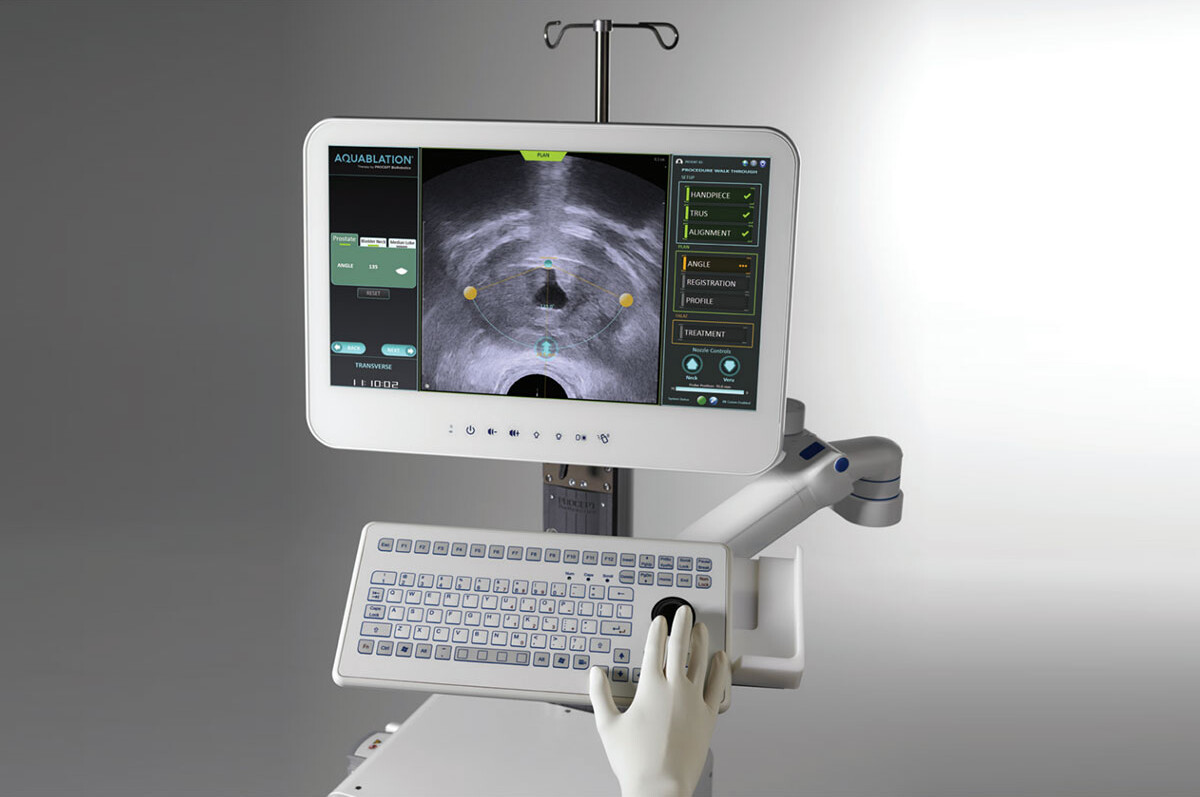Aquablation of the Prostate
We are excited to be pioneering a truly game changing treatment for treating Benign Prostatic Hyperplasia (BPH) and Neil Barber has been involved in the trials of this unique and novel procedure. Neil is a recognised world key opinion leader on this technology, and continues to present and teach on the technique around the across Europe and SE Asia (South Korea and Japan), with visiting surgeons coming to the UK to see this procedure in action. Since 2014, Neil has been performing aquablation in and out of studies and has currently performed over 500 cases.
 Aquabeam system
Aquabeam system
Aquablation of the prostate using the Aquabeam system is a heat free (no electricity or laser energy), ultrasound guided, robotically delivered procedure. It is the first new technology looking to remove and ablate tissue to achieve the same kind of outcome as the TURP or lasers for 20 years. Neil Barber has been involved in all the European and global based trials of this technology and its maturation as a procedure since 2014.
Aquablation is performed under general anaesthetic usually, and involves the placement of an ultrasound probe into the rectum and the passing of the Aquabeam handpiece down the waterpipe or urethra. The procedure is planned using software based upon the ultrasound image in 2 planes – producing a 3D model and the water jet is then delivered by the robot through the Aquabeam handpiece following that plan. The surgeon can adjust that plan during the treatment if necessary.
Following treatment, the use of the TURP loop allows secure control of any bleeding and the patient is left with a post operative urinary catheter, in a similar manner to the TURP and lasers. Inpatient stay is usually 1 or 2 nights , the catheter being removed before discharge. As this is a heat free procedure, post operative symptoms settle relatively quickly, but the unique selling point is the ability of this technology to treat (almost) all sizes of prostate with a similar operating time and achieving predictable significant improvements in symptoms with a much lower risk of dry ejaculation (10.8%) in meta-analysis compared to the TURP and lasers and no apparent impact upon erectile function.


 Medical Evidence
Medical Evidence
As of September 2023, NICE has published it's latest interventional procedures guidance and recommends that Aquablation should be a standard arrangement in the NHS as a treatment for BPH. This is very important step forward in bringing this procedure to patients across the NHS and not just in the private sector.
Read the complete paper here.
There is high quality evidence from a number of large trials across the world to support the efficacy and safety of Aquablation as treatment of symptomatic BPH. This includes peer reviewed publications from the landmark prospective randomised global study WATER the multicentred prospective study from the US, WATER 2, and from the real world multicentred study, OPEN WATER, across Europe, confirming
- Efficacy and safety at least as good as TURP
- Maintenance of improvement in symptoms with 5years follow up,
- Efficacy on larger prostates (volumes 80 to 150 mls), including men with catheters in place and in those with poor bladder emptying and in all sizes of prostates.
Putting all this high quality data together, analysis confirms reproducible outcomes in all sizes and shapes of prostates and circumstances with a 11% chance of dry ejaculation and uniquely, no risk of negative impact upon erectile function.
This means that the level of symptom and urinary flow improvements with Aquablation are TWICE as good as for the minimally invasive alternatives, including, Rezum (steam ablation) but still achieving a very low risk of effecting sexual function.
 Summary of the reported findings
Summary of the reported findings
A summary of the reported findings of the WATER Study comparing Aquablation to TURP (current gold standard treatment) includes:
- Significantly improved BPH symptoms in both treatment groups as measured by the International Prostate Symptom Score (IPSS) at six months with 100% of Aquablation patients improving from baseline
- Superiority in IPSS storage symptom sub-scores (p<0.05)
- Superiority in IPSS improvement with Aquablation in men with prostate volume greater than 50 ml as compared to TURP (p<0.01)
- Superiority in peak urinary flow rates (Qmax) at six months
- A significantly lower rate (4 to 1 ratio, p<0.001) of sexual side effects in Aquablation compared to TURP at three months
- Superiority in ejaculatory function (MSHQ-EjD) and incontinence scores (ISI) at three months
In summary, the results are indicating outcomes like TURP and laser treatment but with a far lower risk of sexual dysfunction and speedier recovery. In fact rather than the expected 60 -70% chance of dry ejaculation seen with TURP or laser prostatectomies, aquablation using a non heat technique was associated with a 11% chance of dry ejaculation.
In February 2022, the WATER trial released five year data - you can read the full article here on our news page.
Neil Barber was the first consultant surgeon in the UK to offer this procedure both privately and on the NHS. He is able to carry out this procedure at The London Clinic, The Cromwell Hospital and Ashtead Hospital. To find out more details and to book a consultation with Neil, please contact his secretary here(missing link).
Neil is also carrying out trials for the procedure with patients at his NHS practice at Frimley Park hospital.
In July 2022, Richard Hindley also began been trialing the procedure through his NHS practice at North Hampshire Hospitals in Basingstoke. BBC South Today covered the first procedures he performed and the impact this could have on reducing NHS waiting lists. You can watch the news coverage here(missing link)
Richard is now able to offer this treatment at HCA Princess Grace Hospital in London. Please contact his secretary here for further details.